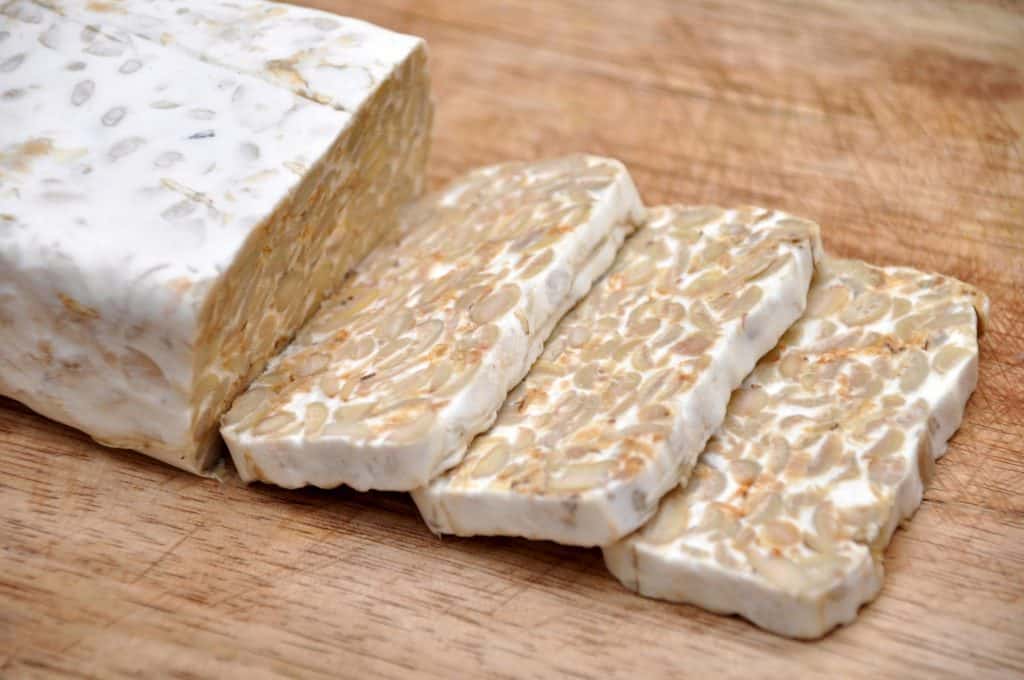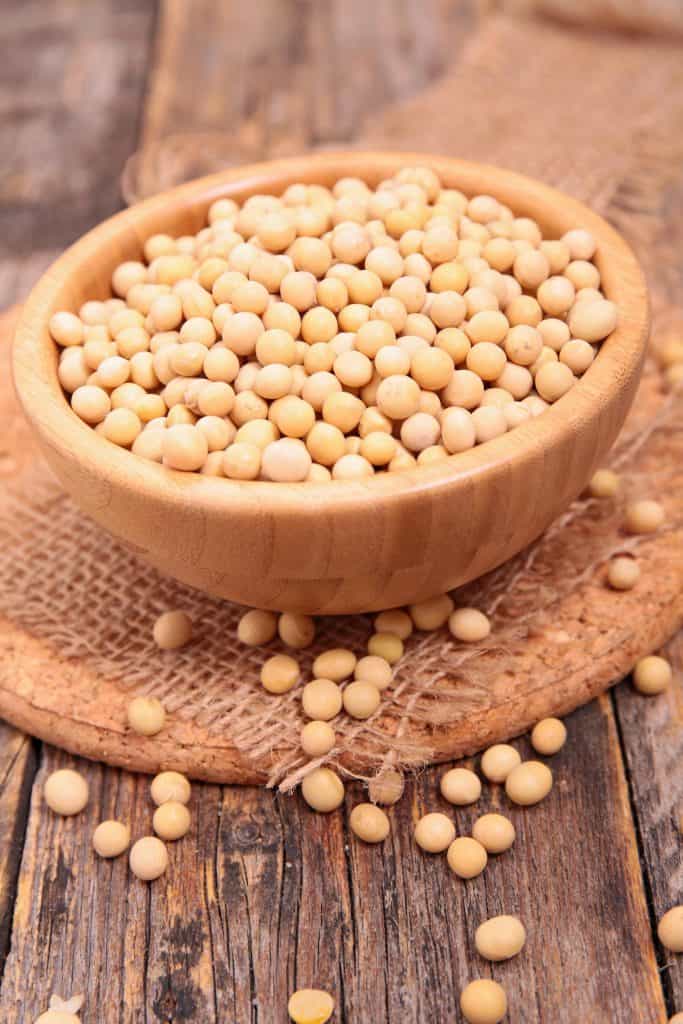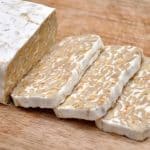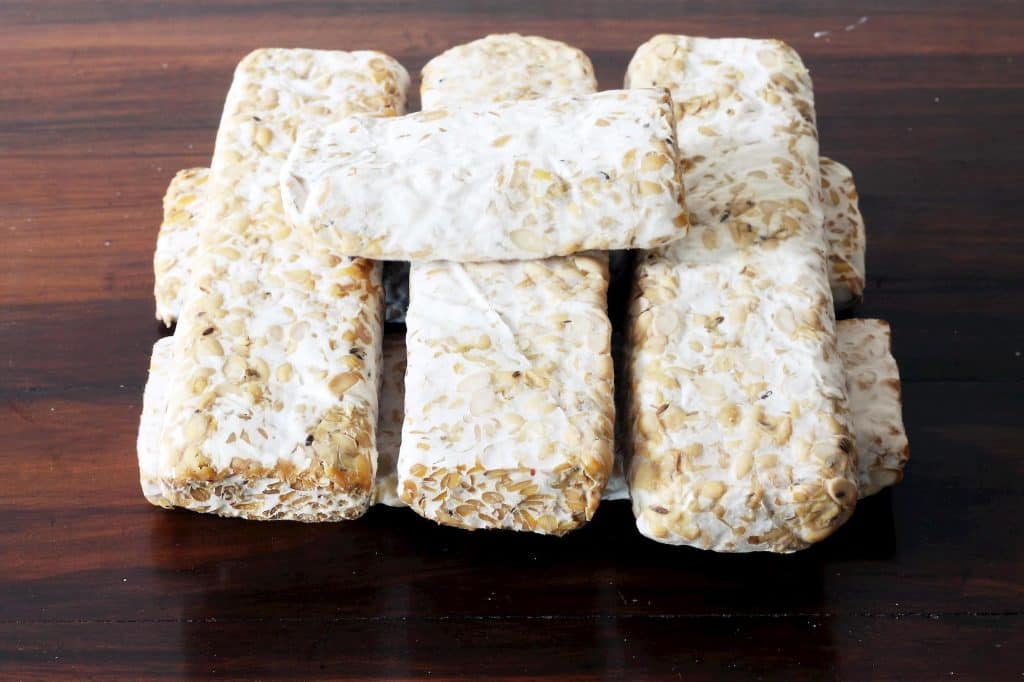
Tempeh is a fermented food that forms an integral part of traditional Indonesian cuisine. It is made from soybean that has been fermented. Alternatively, Tempeh can also be prepared by breaking down the soybeans by subjecting them to the action of microorganisms.
Once fermented, soybeans are compressed into a flat and compact cake that we call Tempeh. It is commonly consumed as a rich source of proteins by vegetarians.
Tempeh has a firm and dry yet chewy texture with a mild nutty taste. You can be baked, sautéed or steamed. Sometimes, it is marinated to enhance its flavors. Marinating Tempeh can add to the complexity of the taste and texture of Tempeh making it a wonderful and irresistible addition to your meals.
Other than soybeans, Tempeh can also be prepared from other varieties of beans, wheat or a combination of wheat and soybeans.
Like most other meatless and vegetarian sources of proteins like seitan and tofu, Tempeh too is a popular choice among vegetarians and vegans as it’s packed with nutritional compounds.
Let’s have a look at how to make Tempeh and the ingredients you would need to prepare it.

Table of Contents
How to make Tempeh
Preparing Tempeh is so easy that you can get started immediately once you get a hold of a good recipe. The ingredients are likely to be already available in your kitchen. And if not, they are easily available at most grocery stores.
Also, unlike other fermented products that need to be fermented for several days and sometimes for months, Tempeh can be prepared or fermented in just two or three days.

Tempeh Recipe
- Total Time: 0 hours
Description
Tempeh is a typical Indonesian food mainly composed of fermented yellow soybeans
Ingredients
- 3 cups dried yellow soybeans
- 5 tablespoons white vinegar
- 1 teaspoon tempeh starter (Rhizopus oligosporus, available in health food stores and online)
Instructions
- In a large glass bowl soak soybeans for 12 hours. You can do that in the morning before leaving for work and continue the tempeh preparation in the evening. Or you can do it a night before you go to sleep so that you can start cooking the next day.
- De-hull and split the beans after 12 hours of soaking. You will notice that most hulls are floating on the surface while soybeans are on the bottom of bowl. Firstly de-hull soybeans then split them in halves. This is the most time consuming task and it may take 30 minutes to complete.
- Cook the soybeans and add vinegar. Firstly drain soybeans, then place them in a large pan and cover them with fresh water. Bring to boil. Add white vinegar and cook for 30 minutes.
- Dry the beans and add tempeh starter. Drain your soybeans once again and cook over low heat until they are completely dry. Let them cool down on the room temperature. Add tempeh starter and stir thoroughly.
- Make compact loaf. Place the mixture inside plumcake mold and press carefully to obtain a compact loaf. Cover the mold with plastic wrap and prick it to allow air to circulate.
- Let it ferment. Put your mold in a warm place with a temperature between 28°C and 32°C (for example in oven with just the light on). Temperature shall be stable to allow fermentation.
- In summer, you can just place your mold in the hottest room of your house, but you may also find new and original ways of achieving the right temperature, like using a yoghurt maker or a lamp to be placed above the mold.
- Ready to be served. After 48 hours you should see a white coating over the surface of your tempeh which means tempeh is ready to be served. You can eat it raw if you prefer slightly bitter taste otherwise cook it to get the nutty flavour.
- Storage. You can keep tempeh in airtight bags or containers in the refrigerator for up to seven days.
Notes
Equipment: large glass bowl, large pan, plumcake mold and plastic wrap
- Prep Time: 1.5 hours
- Cuisine: Indonesian
Nutrition
- Serving Size: 2 ounce
- Calories: 162
- Sodium: 9 mg
- Fat: 9 grams
- Carbohydrates: 9 grams
- Protein: 15 grams
Nutrition
What makes Tempeh a superfood for vegetarians as well as non-vegetarians, is its impressive nutritional profile. It is rich in proteins, vitamins, and minerals while being low in carbs and sodium.
It can provide your body with all the benefits of proteins like improved healing and repair, protection against illnesses, muscle growth, and so on. It can also enhance the bodily functions that are dependent on vitamins and minerals.
However, it provides all these benefits without adding too many calories from carbs. So, if you are conscious of your calorie intake, want to lose weight, or would like to restrict your carbohydrate intake to control diabetes, Tempeh would serve the purpose.
That’s not all. The low-carb content of Tempeh makes it suitable even for keto dieters who are always looking for delicious recipes that contain fewer carbs.
As far as the low sodium content is concerned, it can be a huge advantage for patients who suffer from hypertension. We all know that sodium intake in the form of common salt can increase blood pressure. Tempeh being a low-sodium food, can be safer even for hypertensive patients.
Now that we had a brief idea of the nutrients in Tempeh, let’s continue with learning the vitamins, minerals, and other compounds present in it.
An 84-gram or a 3-ounce serving of Tempeh contains the following nutrients:
- Calories: 162
- Carbohydrates: 9 grams
- Proteins: 15 grams
- Fats: 9 grams
- Sodium: 9 milligrams
- Calcium: 9% of the RDI
- Iron: 12% of the RDI
- Niacin: 12% of the RDI
- Manganese: 54% of the RDI
- Riboflavin: 18% of the RDI
- Phosphorus: 21% of the RDI
- Magnesium: 18% of the RDI
This shows that Tempeh offers a rich source of minerals like iron, calcium, magnesium, phosphorus, and manganese as well as vitamins like niacin and riboflavin.
Where to buy
If you are looking for Tempeh culture, I would recommend you to try the products only from reputed brands. Here are a few good options for Tempeh and Tempeh culture that you can buy online.
Cultures For Health Tempeh Culture
The flavors and nutritional profile of Tempeh you prepare at home depend on the culture you use. I have found Tempeh cultures from the Cultures For Health to be a good option you can use to prepare Tempeh.
It is a starter kit that contains rhizopus oryzae, a form of beneficial fungus or mold that is an important ingredient in making Tempeh. The mold forms a fluffy, white, and edible layer around the beans and binds them together forming firm blocks.
This culture will make it easier for you to prepare Tempeh that can be easily cut into small cubes or thin slices before grilling or pan-frying them.
Each package of this Tempeh culture kit contains 4 packs of soy culture allowing you to make a batch whenever you like.
What I particularly liked about this Tempeh culture kit is it contains only natural ingredients like rice, rhizopus oryzae culture and non-GMO soybeans. It is free of MSG, GMO, preservatives, and gluten.
Tempeh by LightLife
If you are in a rush and can’t take out enough time to prepare Tempeh at home, you can try this Tempeh from LightLife. It is organically prepared ready-to-eat Tempeh. Each pack contains 9 servings of Tempeh in the form of thin slices. You can simply open the pack and consume this delicacy without having to put in time and effort to prepare it.
Fresh Tempeh
Here’s another option of ready-to-eat Tempeh for you. Fresh Tempeh from Orange Grocer comes in a pack of 6 servings. The taste is delicious just as you would expect from homemade Tempeh. It’s definitely worth giving a try.
What is the difference between Tempeh and tofu?
Both Tempeh and tofu are considered the alternatives for meat. Both are rich in proteins and are prepared from natural sources. This is why most people think of Tempeh and tofu to be the same. However, there are a few differences that make both these foods stand apart from each other.
The main difference is Tempeh is a fermented product, while tofu is not. This can be an important consideration, especially for people who are prone to tummy upsets. Tofu is considered a gas-inducing food that may worsen digestive troubles like constipation, flatulence and bloating. Tempeh, on the other hand, being fermented food, can create enzymes that improve digestion. It can help to relieve digestive issues making it a healthier food to include in your regular diet.
Also, Tempeh is less processed than tofu.
What makes Tempeh a better alternative to tofu is its protein content. It is estimated that a half-cup serving of Tempeh has about 15.4 grams of proteins compared to about 10.1 grams in tofu.
Tempeh is also a good source of dairy-free calcium. One cup or 166 grams of Tempeh provides 2/3 of the calcium present in 1 cup of whole milk. Compared to this, the calcium content of tofu is a bit on the lower side.
However, when it comes to calories, Tempeh contains slightly more than that of tofu. This means except for the high calorie content, Tempeh scores over tofu in most parameters of healthy foods.
Having said that; it doesn’t make tofu an unhealthy food. It is definitely a nutritious food. It’s just that Tempeh is better.
FAQs
How to cook Tempeh?
Steaming, marinating and baking are the best ways to cook the Tempeh as given below.
- If you find the Tempeh to be a bit bitter, steaming it would help. Simply slice Tempeh and place them in a saucepan. Cover with water and bring it to a boil. Simmer for 10 minutes before removing it. This process will reduce the bitterness. Now, you can proceed with grilling, baking, or marinating Tempeh the way you prefer.
- You can marinate Tempeh with soy sauce, citrus juice, coconut milk, ginger, spices, peanut butter, or sweeteners such as maple syrup, honey, and agave nectar. This will enhance its flavors and make it more delicious.
- You can also grill or pan-fry thinly sliced Tempeh until its edges become crispy. It will enhance its nutty flavor while retaining its chewy interior.
- Some people prefer blackened Tempeh prepared by coating and searing it with blackening spice. It can be used as a seasoning for salads and sandwiches.
- Alternatively, you can add grated, crumbled, or cubed Tempeh to stew, spaghetti sauce, chili, and curry to improve the taste and flavors of the dish.
What does Tempeh taste like?
Tempeh has strong flavors that can be described as nutty, earthy, mushroom-like.

Is Tempeh healthy?
Yes, Tempeh is certainly healthy and can provide several health benefits as discussed beneath:
- The process of fermentation that the soybean undergo causes the breakdown of phytic acid in soybeans thus improving digestion and absorption.
- Tempeh is rich in probiotics; the beneficial bacteria known to enhance the gut flora and improve digestion.
- Tempeh is rich in proteins. It can stimulate a process called thermogenesis that increases the body’s metabolic rate. This can help you burn more calories and allow you to lose weight easily.
- Tempeh contains natural plant compounds known as isoflavones. Soy isoflavones are associated with decreased cholesterol levels. It can reduce the amount of total cholesterol and triglycerides, thus, helping protect you against heart attacks and strokes.
- Isoflavones in Tempeh possess antioxidant properties that can reduce oxidative stress and prevent free radical damage to healthy organs. By neutralizing free radicals, Tempeh may reduce the risk of cancer, diabetes, and autoimmune diseases.
- Tempeh offers a good source of calcium that is responsible for maintaining bone health and reducing the risk of Osteoporosis.
Is Tempeh good for you?
Tempeh is certainly good for you for a variety of reasons. Including Tempeh in your regular diet can help your body receives a good supply of essential vitamins, minerals, and other nutrients, particularly proteins. It can also protect you against several diseases by supporting the natural healing and repair processes.
Can you eat Tempeh raw?
Yes. Tempeh can be eaten raw. However, most people prefer to cook it before consuming or adding it to chicken or salad, especially if it is coated with an oily mix such as mayonnaise.
The oiliness of mayonnaise can cause the moisture to get trapped in the soybeans while the air gets sealed out. This can create a favorable environment for some bacteria to grow giving Tempeh an unpleasant taste. Cooking Tempeh would help to reduce this unpleasant taste. This is why; some people prefer to cook Tempeh before eating or adding it to dishes.
Conclusion
Whether you are a vegetarian or not, Tempeh could certainly be a nutritious addition to your regular diet. This fermented product, being rich in probiotics, proteins, and a wide range of vitamins and minerals, can bestow your body with several health benefits.
This is why; I do not want you to keep yourself from enjoying the delicious flavors of Tempeh just because you are a non-vegetarian. And if you are a vegetarian, what more could you ask for than the versatile, tempting, and nutritious food like Tempeh!?




Hi,
What can I use instead of plumcake mold? Thank you!
Hi Tanya, you can use glass or ceramic dish.